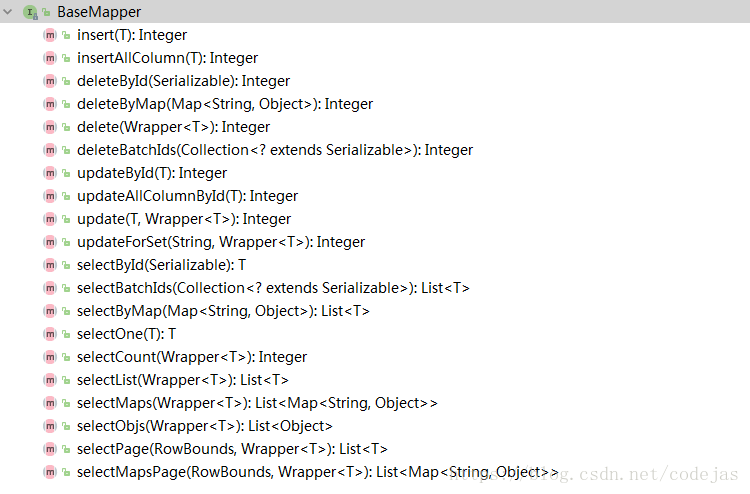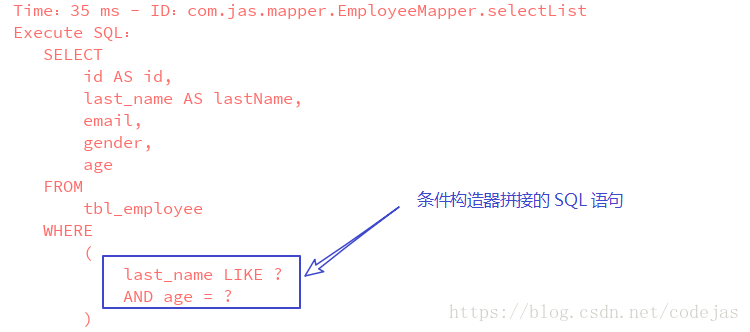MyBatis Plus 入門使用詳細教程
一、MyBatis Plus 介紹
MyBatis Plus 是國內(nèi)人員開發(fā)的 MyBatis 增強工具,在 MyBatis 的基礎(chǔ)上只做增強不做改變,為簡化開發(fā)、提高效率而生。
MyBatis Plus 的核心功能有:支持通用的 CRUD、代碼生成器與條件構(gòu)造器。
通用 CRUD:定義好 Mapper 接口后,只需要繼承 BaseMapper<T> 接口即可獲得通用的增刪改查功能,無需編寫任何接口方法與配置文件條件構(gòu)造器:通過 EntityWrapper<T> (實體包裝類),可以用于拼接 SQL 語句,并且支持排序、分組查詢等復(fù)雜的 SQL代碼生成器:支持一系列的策略配置與全局配置,比 MyBatis 的代碼生成更好用
BaseMapper<T> 接口中通用的 CRUD 方法:

二、MyBatis Plus 集成 Spring
數(shù)據(jù)表結(jié)構(gòu)
DROP TABLE IF EXISTS `tbl_employee`;CREATE TABLE `tbl_employee` ( `id` int(11) NOT NULL AUTO_INCREMENT, `last_name` varchar(50) DEFAULT NULL, `email` varchar(50) DEFAULT NULL, `gender` char(1) DEFAULT NULL, `age` int(11) DEFAULT NULL, PRIMARY KEY (`id`)) ENGINE=InnoDB AUTO_INCREMENT=8 DEFAULT CHARSET=utf8;
pom 文件
<dependencies> <!-- MP --> <dependency> <groupId>com.baomidou</groupId> <artifactId>mybatis-plus</artifactId> <version>2.3</version> </dependency> <!-- 測試 --> <dependency> <groupId>junit</groupId> <artifactId>junit</artifactId> <version>4.12</version> </dependency> <!-- 數(shù)據(jù)源 --> <dependency> <groupId>com.alibaba</groupId> <artifactId>druid</artifactId> <version>1.1.10</version> </dependency> <!-- 數(shù)據(jù)庫驅(qū)動 --> <dependency> <groupId>mysql</groupId> <artifactId>mysql-connector-java</artifactId> <version>5.1.39</version> </dependency> <!-- Spring 相關(guān) --> <dependency> <groupId>org.springframework</groupId> <artifactId>spring-context</artifactId> <version>4.3.9.RELEASE</version> </dependency> <dependency> <groupId>org.springframework</groupId> <artifactId>spring-orm</artifactId> <version>4.3.9.RELEASE</version> </dependency> </dependencies>
MyBatis 全局配置文件 mybatis-config.xml
<?xml version='1.0' encoding='UTF-8' ?><!DOCTYPE configuration PUBLIC '-//mybatis.org//DTD Config 3.0//EN' 'http://mybatis.org/dtd/mybatis-3-config.dtd'><!-- 不作任何配置 --><configuration />
數(shù)據(jù)源 db.properties
jdbc.url=jdbc:mysql://localhost:3306/mpjdbc.username=rootjdbc.password=1234
Spring 配置文件 applicationContext.xml
<!-- 數(shù)據(jù)源 --> <context:property-placeholder location='classpath:db.properties'/> <bean class='com.alibaba.druid.pool.DruidDataSource'> <property name='url' value='${jdbc.url}'></property> <property name='username' value='${jdbc.username}'></property> <property name='password' value='${jdbc.password}'></property> </bean> <!-- MP 提供的 MybatisSqlSessionFactoryBean --> <bean class='com.baomidou.mybatisplus.spring.MybatisSqlSessionFactoryBean'> <!-- 數(shù)據(jù)源 --> <property name='dataSource' ref='dataSource'></property> <!-- mybatis 全局配置文件 --> <property name='configLocation' value='classpath:mybatis-config.xml'></property> <!-- 別名處理 --> <property name='typeAliasesPackage' value='com.jas.bean'></property> <!-- 注入全局MP策略配置 --> <property name='globalConfig' ref='globalConfiguration'></property> <!-- 插件注冊 --> <property name='plugins'> <list> <!-- 注冊分頁插件 --> <bean /> <!-- 注入 SQL 性能分析插件,建議在開發(fā)環(huán)境中使用,可以在控制臺查看 SQL 執(zhí)行日志 --> <bean class='com.baomidou.mybatisplus.plugins.PerformanceInterceptor'> <property name='maxTime' value='1000' /> <!--SQL 是否格式化 默認false--> <property name='format' value='true' /> </bean> </list> </property> </bean> <!-- 定義 MybatisPlus 的全局策略配置--> <bean class='com.baomidou.mybatisplus.entity.GlobalConfiguration'> <!-- 在 2.3 版本以后,dbColumnUnderline 默認值是 true --> <property name='dbColumnUnderline' value='true'></property> <!-- 全局的主鍵策略 --> <property name='idType' value='0'></property> <!-- 全局的表前綴策略配置 --> <property name='tablePrefix' value='tbl_'></property> </bean> <!-- 配置mybatis 掃描mapper接口的路徑 --> <bean class='org.mybatis.spring.mapper.MapperScannerConfigurer'> <property name='basePackage' value='com.jas.mapper'></property> </bean>
三、快速體驗 MyBatis Plus
實體類 Employee
@TableName(value = 'tbl_employee')public class Employee { @TableId(value = 'id', type = IdType.AUTO) private Integer id; @TableField(value = 'last_name') private String lastName; private String email; private Integer gender; private Integer age; public Employee() { super(); } public Employee(Integer id, String lastName, String email, Integer gender, Integer age) { this.id = id; this.lastName = lastName; this.email = email; this.gender = gender; this.age = age; } // 省略 set、get 與 toString() 方法
mapper 接口
/*** 不定義任何接口方法*/public interface EmployeeMapper extends BaseMapper<Employee> {}
在測試類中生成測試的 mapper 對象
private ApplicationContext context = new ClassPathXmlApplicationContext('classpath:applicationContext.xml'); private EmployeeMapper employeeMapper = context.getBean('employeeMapper', EmployeeMapper.class);
簡單查詢測試
@Test public void getEmpByIdTest() { Employee employee = employeeMapper.selectById(1); System.out.println(employee); }
分頁查詢測試
@Test public void getEmpByPage() { Page<?> page = new Page<>(1, 5); List<Employee> list = employeeMapper.selectPage(page, null); System.out.println('總記錄數(shù):' + page.getTotal()); System.out.println('總頁數(shù)' + page.getPages()); System.out.println(list); }
條件構(gòu)造器測試
@Test public void getEmpByName() { EntityWrapper<Employee> wrapper = new EntityWrapper<>(); // ’last_name’ 與 ’age’ 對應(yīng)數(shù)據(jù)庫中的字段 wrapper.like('last_name', '張'); wrapper.eq('age', 20); List<Employee> list = employeeMapper.selectList(wrapper); System.out.println(list); }
控制臺輸出的 SQL 分析日志

上面幾個例子中,并沒有在 EmployeeMapper 接口中定義任何方法,也沒有在配置文件中編寫 SQL 語句,而是通過繼承 BaseMapper<T> 接口獲得通用的的增刪改查方法,復(fù)雜的 SQL 也可以使用條件構(gòu)造器拼接。
通過這兩種方式已經(jīng)能夠滿足很多的開發(fā)需求了,不過復(fù)雜的業(yè)務(wù)需求還是要編寫 SQL 語句的,流程和 MyBatis 一樣。
PS:完整的代碼(mybatis-plus-demo 目錄)傳到了 GitHub,包括 SQL 表結(jié)構(gòu)與數(shù)據(jù)文件,點我前往~
總結(jié)
相關(guān)文章:

 網(wǎng)公網(wǎng)安備
網(wǎng)公網(wǎng)安備